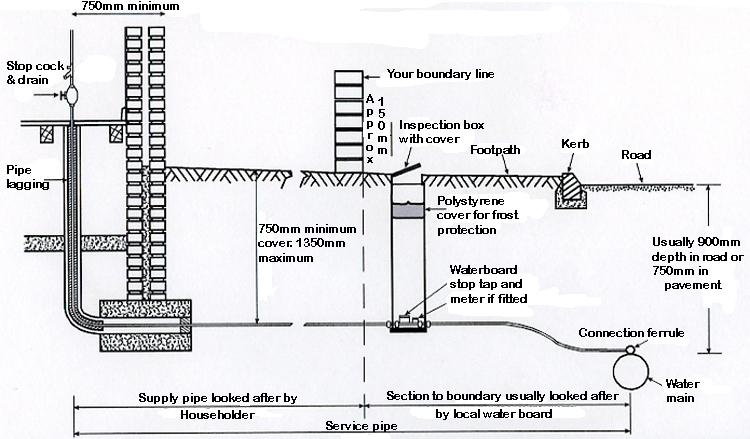Why would I want to change Lead or Iron Water Pipes?
Until the 1960’s lead was used for almost all water supply pipes and although the water is treated by your local authority, small amounts of lead can find their way into the water you use. This also applies to rust from iron pipes. All local authority water boards will, if asked, take samples of your water and test it for you free of charge.
You are responsible for all of the pipework in your property and for the pipe work between your property and the boundary of the street the main is in. This main will normally be fairly close to the property boundary. The diagram below outlines the situation found with most properties but there are exceptions to this rule. In the case of an exception, such as you property being beyond the end of a main, contact your local water board to see who is responsible for the incoming pipe.

Lead water main cross section
If you share a water pipe with a neighbour you are jointly responsible for that pipe. If you then want your own connection to the main you may have to pay for this.
What do I Change Lead Watermain Pipework to?
The new pipe should be a blue plastic pipe which is made from Medium Density Polyethylene (MDPE). It will have a minimum of 25mm external diameter until it gets to your internal stop tap when copper is usually installed. If however there is any possibility that your ground, or the ground surrounding your property may be contaminated with petrol or oil or other hydrocarbons, MDPE must not be used. In these situations a special foil wrapped pipe must be used.
What do I do if I Want to Change Lead Mains Water Pipes?
Contact your local water authority. They will come out and check if you share a supply with anyone. They will advise you if there would be any charge and advise you on where to lay your new pipe.
Where to Lay New Pipework
You will, in most cases, be expected to lay your new pipe slightly beyond the property boundary for connection to the main by the local water company. You will also need to get prices from local plumbers for changing the internal pipes from lead to copper.
Depth of New Watermain Pipework
Your pipe must be laid in a trench between 750mm and 1350mm deep and it must enter the property and remain at that depth for a minimum of 750mm from the external face of the wall of the property. It will then rise up to the internal stop tap usually located under the kitchen sink.
Lagging and Insulation of New Pipework
From the bend upwards and for all pipes higher than 750mm deep the pipe must be insulated to BS 6700.
Lagging must also be used for all lengths of pipe passing through unheated parts of the property such as basements and underfloor voids. The lagging insulation should be as follows:
- For a 25mm pipe, 28mm of insulation must be used
- for a 32mm pipe, 35mm of insulation must be used
- The insulation must also be designed for frost protection
Do I Have to Change Anything Else?
When your new pipe is installed to your stop cock, if the first internal length of pipe, i.e. the length of pipe from your stop cock to the first (drinking water) tap is lead or iron, this must be replaced also.
Passing Through Foundations and Under Buildings
If the new pipe needs to pass through any foundations or is buried under the building, it must be placed in a duct of at least 100mm diameter. The duct must allow for the pipe to be insulated and a wire must be laid next to the pipe, and clamped to it when it gets inside the property, to trace or pull through a new pipe should any faults develop.
Get it Checked
Before you fill the trench in a member of the local water authority must inspect it to make sure it has been laid correctly.
Earthing
Please check that your old water pipe, where it entered the building, was not used as an earthing point as many were pre 1966. You need to contact and electrician if you are in any doubt.
Filling the Trench for Your New Watermain
When you backfill the trench care should be taken. No stones or bricks should be near the pipe, nor should any other sharp objects. For safety’s sake it is recommended that the first 100mm of backfill be sand and the pipe itself is laid on 100mm of sand also. It is as well to keep the rest of the backfill free of aggressive materials.
A range of MDPE fittings can be seen below:

MDPE Reducing Coupler

MDPE Coupler

Stop Tap

MDPE Pipe Insert

MDPE Blue pipe

MDPE Female Adaptor

MDPE Male Adaptor

MDPE Equal Tee

MDPE Elbow

